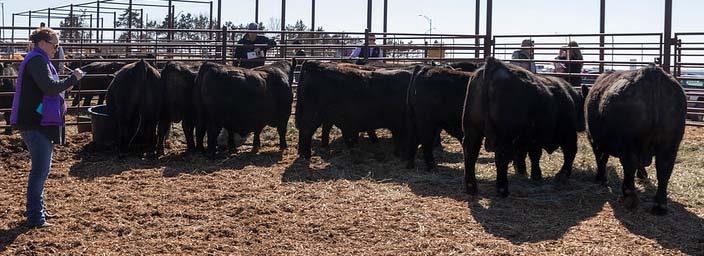
When selecting a bull, knowing the marketing plan for the calves will help in prioritizing traits, K-State beef cattle geneticist Bob Weaber said. | Download photo
Cattle Chat: Selecting bulls to meet marketing goals
K-State beef cattle geneticist explains how marketing endpoints influence purchasing decisions
At a glance: K-State beef cattle geneticist Bob Weaber offers bull section tips for sires used to create replacement heifers in the herd.
More information: Bob Weaber, 785-532-2281, bweaber@ksu.edu
Related: Beef Cattle Institute Cattle Chat
Feb. 25, 2025
By Lisa Moser, K-State Research and Extension news service
MANHATTAN, Kan. – When assembling a product, it is important to have the right tool to make the building process go smoothly.
Similarly, cattle producers can make the calving process go smoothly by selecting the right bull to mate with the cows, said the experts at Kansas State University’s Beef Cattle Institute.
Speaking on a recent Cattle Chat podcast, K-State beef cattle geneticist and head of the Eastern Kansas Research-Extension Centers Bob Weaber said before making a bull purchase it is important to know how his offspring will be marketed.
“Understanding the marketing endpoint of the calves will help identify the important traits for the bull selection,” Weaber said. “I recommend producers separate the maternal and terminal mating decisions wherever possible in the herd.”
For example, for sires that will be used to create replacement heifers, Weaber recommends producers prioritize a selection index that is focused on cow productivity.
For bulls mated to heifers, he said it is important to look at the calving ease traits, but that the lowest calving ease sire may not be the best for heifers that are making females that will be retained in the herd long term.
“The relationship between calving ease direct and maternal calving ease is negative, which means that easy calving heifers can have, over time, sequentially lower maternal calving ease,” Weaber said.
He said that calves sired by high calving ease bulls will have light birthweights, which can create a management-induced challenge.
“Light birthweight calves born on the range in a blizzard may not survive so our goal in making those matings is to create a calf with adequate body weight at birth with a low dystocia rate,” Weaber said. “To do that, we need to manage and develop our replacement heifers correctly so they have an adequate size and stamina to get through the calving process.”
He recommends that producers select bulls that are adequate in the calving ease direct trait, but not ones that are extreme for that trait.
In addition, Weaber said that one way for producers to create both maternal matings and terminal matings in the herd is through the use of artificial insemination, or AI.
“Using gender-sorted semen through AI can be an effective way to build targeted replacement heifers, and then let the bull sire the calves that will be marketed at weaning,” Weaber said. “That way you used technology to manage your breeding strategy to achieve that separation of maternal and terminal matings.”
To hear the full discussion, listen to Cattle Chat on your preferred streaming platform.
***

K‑State Research and Extension is a short name for the Kansas State University Agricultural Experiment Station and Cooperative Extension Service, a program designed to generate and distribute useful knowledge for the well‑being of Kansans. Supported by county, state, federal and private funds, the program has county extension offices, experiment fields, area extension offices and regional research centers statewide. Its headquarters is on the K‑State campus in Manhattan. For more information, visit www.ksre.ksu.edu. K-State Research and Extension is an equal opportunity provider and employer.